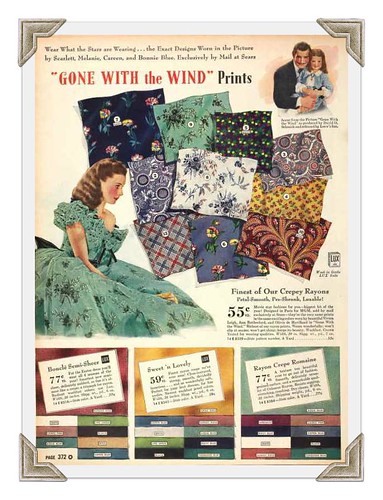 |
| Sears Roebuck Catalog, Spring 1940 |
I have had a couple of questions about my rayon pre-treating
methods, so I though I would write about my experience with the fiber. The quick answer is that I pre-wash just
about every length of fabric before cutting into it (either in the machine or by hand), and I always hand wash the items that I sew.
Take a quick peek in my closet, and it is clear that I am a
huge fan of rayon. I understand that it
is a synthesized fabric, but as it is made from plant material, I consider it to be a
natural fiber. As I am no chemist, I am
not going to get into any definitions of what constitutes a natural versus
synthetic fabrics - I just know that I love rayon and hate polyester.
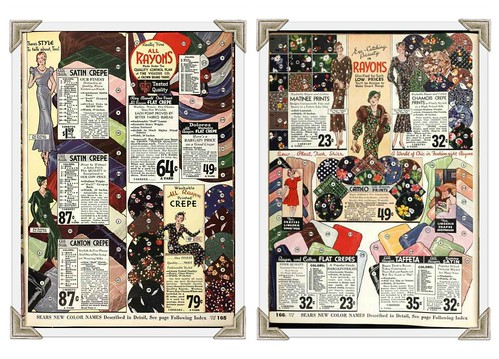 |
| Sears Roebuck Catalog, Fall 1932 |
Rayon (or artificial silk) breathes well and drapes
beautifully, making it perfect for reproduction vintage. I also consider it easier to work with and
care for than silk, but that is just me!
I should start by saying that I have inherited a dislike of
dry cleaning from my mother. Does anyone
know what those chemicals really do?
Because of this (and the exorbitant price), I hand wash the majority of
my clothing and 100% of the clothing that I sew myself. Crazy? Perhaps. But I am certainly not going to
leave a dress that I spend hours constructing to the mercy of a machine. At the moment I am using Eucalan (advertised as a "no rinse delicate wash" although I do rinse it out), but in the
past I have had excellent results with a liquid dish soap like Joy.
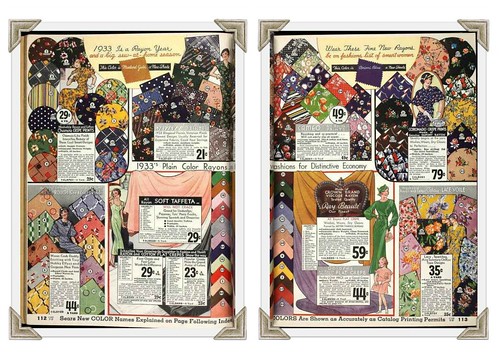 |
| Sears Roebuck Catalog, Spring 1933 |
I had a couple of unfortunate experiences with purchased
rayon dresses, but did learn a little something: rayon is super wonky (yes, that’s a technical
term) when wet. I would hand wash a long,
bias cut dress with a dry clean only label and leave it to drip dry.
When wet, the dress shrunk up to be about 10" too short and 10” too
wide. To redeem the garment, I would
gently tug on the wet fabric to try to get it back to its original shape.
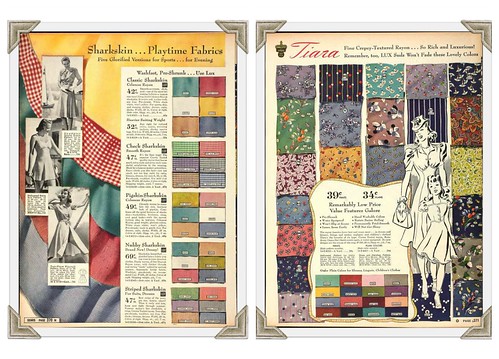 |
| Sears Roebuck Catalog, Spring 1940 |
Rayon is often referred to as “unstable” when wet, and boy,
is that true. It also becomes very
fragile. Once I even managed to tear the
fabric with my thumb while pulling on it.
It turns out I should have left the thing to dry at its own pace. It took me longer to realize this than I care
to admit, but nine times out of ten, as
the fabric dries, it will regain its original shape.
 |
| Sear Roebuck Catalog, Spring 1940 |
The best advice that I can offer is to leave those dresses
alone while drip drying. If the dress is
purchased, there is not a lot you can to do guarantee that something weird is
not going to happen. You can always go
the dry cleaning route as suggested by the care instructions, but for me personally, I am not
going to spend almost as much money to clean it as the darn thing originally cost me. (Now, if I ever come across a 1940s evening gown or vintage 1950s
Dior or Lilli Ann suit from a thrift or antique store, I would obviously make
an exception.)
 |
| Sears Roebuck Catalog, Fall 1932 |
I moved a couple of years ago and now have a front loading
machine. Whoo-hoo! My standard operating procedure
these days is to pre-wash my yardage (including rayon) on the delicate cycle in
the machine and throw it in the dryer until it is damp, at which point I iron
out any wrinkles. If something is extra
special, I will hand wash the yardage in the sink and let it drip dry.
 |
| Sears Roebuck Catalog, Fall 1926 |
The idea is to be as hard on the material as I ever will
be. Because I am going to hand wash the finished
product, it should be perfectly safe since it has already been through a
machine cycle.
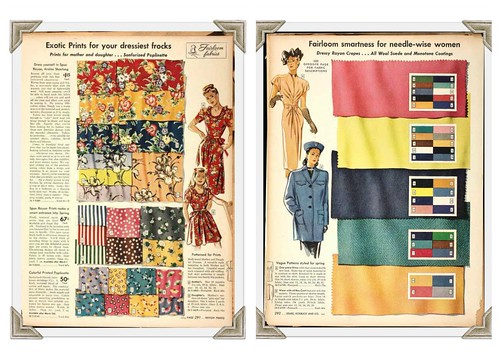 |
| Sears Roebuck Catalog, Spring 1946 |
Sorry this post turned out to be so long, but hopefully it answers
some of those questions!
 |
| Sears Roebuck Catalog, Spring 1933 |
Does anyone else have any rayon suggestions? I would love to hear your experiences.

You are a girl after my own heart. i have a Miele front loading washer ( 18 years now) the 'wool wash' is wonderful. Also hate polyester ....
ReplyDeleteI too am a lover of rayon. I always preshrink my fabric. I wash in my front load washer and lay the fabric on my clothes drying rack to dry. Am able to drape the fabric on the rack without having it hang. Drying it in the dryer sounds scary to me even if for a short time. Good to know it can be done. I do wash my dresses in the front load machine and then hang to dry. Have never had a problem. Like you, I preshrink, by washing, almost everything that I am going to sew. I will never forget years ago wanting to preshrink fabric that my MIL wanted me to use to make pants for my son, she didn't want me to do it. After preshrinking there was no longer enough fabric to cut out the pants. This just reinforced my thought that you must preshrink your fabric. I would have gone to all that work only to have the garment worn once and then discarded as too small.
ReplyDeleteIf I'm correct in thinking that rayon is what tends to be called viscose in the UK then I'm a huge fan. I don't like silk because it always feels "soapy" to me so I'd never sew with it. I always pre-wash viscose in my machine (because I machine wash all my clothes). The only problem I've ever had with it is that it occasionally comes out of the machine like a horrible creased rag - but I'd rather find that out through a pre-wash than after I've spent time sewing a garment.
ReplyDeleteYep - Rayon is called viscose in the UK!
DeleteWhat an excellent, helpful post. Thank you very much for putting this tome on rayon together for us, sweet gal. I don't have any additional tips to add, but will chime in that I'm a big rayon fan myself, too! :)
ReplyDelete♥ Jessica
Ack I was always told not to wash rayon - but maybe I can? I'm worried cos I didn't preshrink my latest 40s dress I made and now I guess I can't ever wash it lest it shrink.
ReplyDeleteI also bought some spectucular vintage rayon - do I prewash that too? I'm terrified of ruining it (quite sheer) as it's literally irreplaceable.
Maybe I should cut a square (measured) piece and test that first? What do you think?
I agree. I adore rayon! It's close enough to be a natural fiber to me and it's comfortable and breathable, which are most important. I always machine wash mine on delicate and line dry (which usually requires ironing). Thanks for noting it's lack of stability when wet. I've not yet had an issue with this but, should I ever, I'll know to leave it alone.
ReplyDeleteI agree too,my granmother was sewing for "Ladies" in Paris and each time she baught natural material,she pre washes it.So i do the same,and i have not a lot of bad surprises.
ReplyDeleteTo dry quickly,i roll the material in sponge sheet,if colors want to dribble!
I noticed you mentioned a front-loading machine. Is it better than the 'top loader'?
ReplyDeleteThey certainly use less soap (1/3 as much), less water, and because they can spin so rapidly and extract so much moisture you reduce time in the dryer (less total electricity consumption). Everyone with a front-loader LUVS the savings, and the fact that without a spindle they hold more than that little door would have you believe is possible.
DeleteAs for drying things from a top-loading machine, cotton dress shirts can be dried for ten (10!) minutes (leaving it just damp), immediately put on a hanger on the line, and left to dry with only a light ironing touch up necessary. This saves electricity, and the shirt from being "cooked" and prematurely frayed about the cuffs and collars. Apply that to dresses and the like, and you may save ironing time without sacrificing fabric integrity with just a smidge of dryer time.
In New Zealand, top-loaders are de rigeur, and anyone with a front loader is generally supposed to have spent too much time in Europe.
DeleteI'm not ashamed of that. I find that my Bosch front loader is much easier on clothes and it does a better job. Apparently, it's all to do with the fact that the water gets pushed through the clothes by gravity in a FL, rather than the clothes being pushed through the water, as in a TL. I don't own a dryer so can't comment on that, but I always find that the FL does a better job getting the water out than the TL did. And it uses less water.
Rayon has such a beautiful drape. Those ads for material are just gorgeous! Makes me want to go back in time and buy them all up.
ReplyDeleteMe too! I would love to go back with today's money and grab up a million yards at 40 cents per yard for silks and fabulous patterned rayons!
DeleteOh, man, I love rayon. It's the best fiber for hot weather - breathes so well & dries SO FAST (and I'm a sweaty lady haha). And maybe I'm sewing wit the "wrong" rayon, but I've never experienced the cutting frustrations that I hear people talking about when they refer to rayon.
ReplyDeleteI wash my handmade garments in the washer on gentle, and hang them to dry on my back porch. One of the best parts about hanging clothes to dry (other than saving $$ on electric & not worrying about the dryer tearing up something delicate!) is that it pretty much eliminates wrinkles. I don't mind pressing when I sew, but I HATE ironing. So it's a win haha :)
Isn't it funny how the iron can be a lifesaver when you are in the middle of a project, but it is simply evil as soon as you finished?! I feel the same way about mending of any kind. Once a garment is done, I don't want to mess with it.
DeleteMy apartment does not have any outdoor access without going down multiple flights of stairs, so my clothes have to drip in the bathtub. I do miss drying things in the sun, but the tension rod in the tub works almost as well!
Rayon is both a silk substitute and a fabulous fiber! I think it's usually made from wood pulp of one kind or another, so while it is man-made, it's also a natural fiber. Cotton, linen, and silk have to go through substantial processing before they can be turned into weavable fibers, too.
ReplyDeleteI always pre-wash and dry my fabrics, whether rayon, linen, or cotton. For silks, I hand wash them in Johnson's Baby Shampoo (since it's a protein fiber like hair), then roll in a towel to blot out excess water, then hang to dry. Rayon does shrink substantially, but that's all the more reason to wash and dry before cutting, and to buy a bit of extra yardage. I prefer to get a little shrinking out of the way, so I dry it on low heat in a clothes dryer. That way, it's less likely to shrink beyond wearability once it's made into a garment.
Steph - great tip about rolling yardage in a towel. I always do that for my handknit sweaters, but manage to forget when I am washing my fabric.
DeleteAnd I totally agree - I would so much rather have something shrink way down BEFORE I cut out my pattern pieces.
I have a few vintage rayon dresses to clean overall, I will use your machine washing techniques. However, I love to iron, so at what point should I do a finish pressing? Completely dry or just about to the point of drying.
DeleteIt is the underarm smells that I need to deal with first...thinking a vinegar spot soak.
"I love rayon and hate polyester." I could not agree more! When I've sewn with rayon it's mostly been knits, which are so much more breathable than their poly rivals.
ReplyDeleteI treat my fabrics similarly to how you do. Nice to have my methods validated! ;-)
I, too, love rayon and, in general hate poly. I throw rayon yardage in the washer and dryer. I try to remember to take it out before it is completely dry, but often I get busy and forget. I really don't baby it at all. I figure if it survives that first wash/dry, it will survive my wear and care after I make it into a garment. Love it!
ReplyDeleteI hear you about the cost of dry cleaning. I just took my first yardage to be dry cleaned and couldn't believe the cost. It was like buying the fabric twice! I won't be doing that again. I didn't even try to wash a sample as I had thought about. Plus, I hate the idea of it swimming in those chemicals. My machine has a handwash cycle that works well. That's my route from now on!
ReplyDeleteWell I often wondered what Rayon was and Clio has solved the query - I know it as viscose. I had a terrible result with some poly not so long ago so I'll never be using it again. Thanks for this info and what wonderful fabrics they had in 1930s.
ReplyDeleteThose fabrics really are amazing! I dream of coming across a warehouse full of pristine vintage yardage.
DeleteGreat post regarding Rayon. I wash all my fabrics. I don't dry clean my clothes because of the smell of the chemical use to clean the clothes.
ReplyDeleteSo happy to see this post of yours!
ReplyDeleteI was debating whether I should attempt to handwash my storebought linen jacket with rayon lining this weekend and I'm still undecided...
That's a difficult decision . . . structured pieces really do not take well to shrinkage. I wish you luck!
DeleteI don't think most rayons are as delicate as people assume they are. They *do* shrink, if not pre-washed, and the trouble with store-bought garments (new or vintage) is that manufacturers cheat us and save a little money by not pre-shrinking the fabric before they construct the garment.
ReplyDeleteI always, always, always wash every single piece of fabric in the machine, and dry it in the dryer, before I cut and sew. In 25 years of sewing and using vintage fabric I have never ruined a piece of rayon by putting it through the washing machine and dryer -- and my dryer has only super hot and absolutely cold settings, so I typically use super hot!
Perhaps I'm include to fabrics that are naturally sturdier than some? But I have successfully pre-washed and dried rayon crepe, rayon/wool blend suiting, rayon satin, rayon chiffon, and so on. The only downside is, as I said, the fabric shrinks, so you end up with less!
I've had a 20 year running argument with my man about the whole "rayon is a natural / rayon is a synthetic fiber". My stance is that if it shrinks when drying, it's a natural fiber ;)
ReplyDeleteI love rayon as well, but unfortunately I have to pre-shrink everything because the afore-mentioned man tends to hot-wash and -dry everything when he does the laundry! Can't complain or I'd be destined to do all the laundry for the rest of our days....